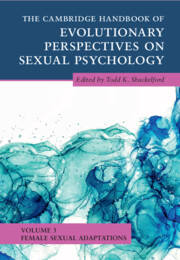Book contents
- The Cambridge Handbook of Evolutionary Perspectives on Sexual Psychology
- The Cambridge Handbook of Evolutionary Perspectives on Sexual Psychology
- Copyright page
- Contents
- Contributors
- Preface
- Part I Precopulatory Adaptations
- 1 Women’s Preferences: Precopulatory Adaptations
- 2 Female Sexual Attraction Tactics
- 3 Extra-Pair Sexual Interest
- 4 Female Intrasexual Competition
- 5 Female Intersexual Selection
- 6 Evolution of Precopulatory Defense from Rape and Coercion in Women
- 7 Mate Poaching
- Part II Copulatory Adaptations
- Part III Postcopulatory Adaptations
- Index
- References
4 - Female Intrasexual Competition
from Part I - Precopulatory Adaptations
Published online by Cambridge University Press: 30 June 2022
- The Cambridge Handbook of Evolutionary Perspectives on Sexual Psychology
- The Cambridge Handbook of Evolutionary Perspectives on Sexual Psychology
- Copyright page
- Contents
- Contributors
- Preface
- Part I Precopulatory Adaptations
- 1 Women’s Preferences: Precopulatory Adaptations
- 2 Female Sexual Attraction Tactics
- 3 Extra-Pair Sexual Interest
- 4 Female Intrasexual Competition
- 5 Female Intersexual Selection
- 6 Evolution of Precopulatory Defense from Rape and Coercion in Women
- 7 Mate Poaching
- Part II Copulatory Adaptations
- Part III Postcopulatory Adaptations
- Index
- References
Summary
Over human evolutionary history, women have benefited from competing with same-sex mating rivals to acquire and retain desired mates. Winning a rivalry may lead to direct advantages, such as securing an attractive, healthy mate who has the ability and willingness to invest in a relationship, as well as possessing important resources that may help sustain future children. Simultaneously, such competition is associated with potential costs, such as jeopardizing alliances, being victimized within social networks, becoming the target of malicious gossip, or, in the case of a loss, wasting one’s time and effort that could have been allocated elsewhere. Here I first present the evolutionary framework that underpins women’s intrasexual mating competition, and then review the existing literature on the specific ways that this competition is manifested. Attention is especially paid to competition via physical attractiveness, namely women’s efforts to improve or enhance their attractiveness, given men’s universal tendency to prefer attractive mates. I focus on how this competition typically utilizes indirect aggression tactics and relies on women behaving in a strategic manner that depends on the local environment, such as the number of available mates, the mate value of potential rivals, and concerns about maintaining one’s reputation.
- Type
- Chapter
- Information
- Publisher: Cambridge University PressPrint publication year: 2022
References
- 1
- Cited by

